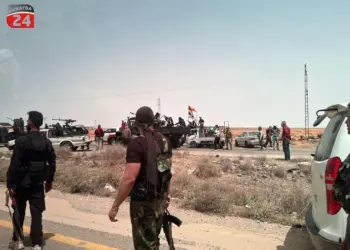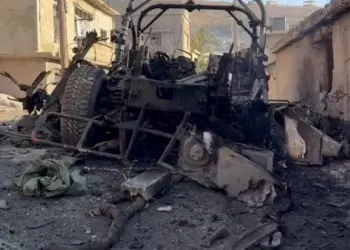Despite interim authorities fully withdrawing all its forces and affiliated armed groups from Suwayda following a tentative truce reached mid-week, Bedouin armed groups launched a new attack on the province’s western countryside late on Thursday. As interim authorities withdrew, some Druze factions began attacking Bedouin settlements, committing extra-judicial killings of civilians, and forcing families to leave towards Daraa or Damascus. This is now being used as justification for the Bedouin attack against Suwayda, and will add to ongoing cycles of violence destabilizing the south. Up to 1,000 Bedouin fighters already inside Suwayda in the early hours of Friday were later bolstered by various local Bedouin armed groups from Daraa, Deir Ezzor and Rural Damascus. Although interim authorities are framing the latest attack as a groundswell retaliation by Bedouins in the south, General Security personnel on the ground are supporting advancing Bedouin troops with ammunition and vehicles. The deployment of Bedouin forces from other areas of Syria to take Suwayda at this point represents a kind of sectarianized insurgency, and the lack of command-chain control throughout pro-government forces significantly raises the risk of unchecked violence against Druze civilians.
Background
After a significant operation by pro-government forces meant to exact all-out surrender from anti-government Druze factions in Suwayda, a tentative truce agreement was reached 16th July that saw interim authorities withdraw advancing forces and purportedly hand over administration to the Druze leadership in the province. In the early hours the following day, interim President Ahmad al-Shara’a delivered a televised address in which he hailed regional and international mediation for helping to broker the Suwayda truce and framed recent violence as an Israeli attack on Syrian territory and unity. Al-Shara’a offered piecemeal reassurances to the Druze community and stated that the truce would allow Suwayda’s Druze leadership to be responsible for security in the province.
Although interim President al-Shara’a framed the truce agreement as a win for interim authorities, an escalating wave of Israeli airstrikes since 15th July was one of the major motivations for interim authorities’ winddown in Suwayda. Israeli airstrikes against advancing pro-government forces in Suwayda, and military bases in Daraa, killed approximately 300 fighters and wounded several hundred others. Israeli strikes targeting the People’s Palace and Ministry of Defense building in Damascus also delivered a clear threat to the highest echelons of power in Syria that the disarmament of Suwayda and violations against Druze communities in the province represented a red line for Tel Aviv.
Military Developments
In step with the truce agreement and mounting Israeli airstrikes in south Syria and Damascus mid-week, all forces affiliated with interim authorities withdrew from the entirety of Suwayda province by the early hours of Thursday. This withdrawal included all Ministry of Defense, General Security, police and irregular units involved in this week’s escalation in Suwayda. Following interim authorities’ withdrawal, Druze factions spread out across Suwayda once again. Late on Thursday night, however, several hundred Bedouin fighters entered western Suwayda from eastern Daraa’s Busra al-Harir to attack towns and villages in the area—the second such attack in a week. Throughout the night, advancing Bedouin groups managed to seize control of several towns in the western Suwayda countryside, prompting more displacements of Druze civilians.
The initial withdrawal of interim authorities’ forces from Suwayda saw Druze factions spread out across the province once again, mirroring the situation before the recent outbreak of violence. At this point, reports began to emerge of Druze factions attacking Bedouin settlements, committing extra-judicial killings of civilians, and forcing families to leave towards Daraa or Damascus. This is now being used as justification for the Bedouin attack against Suwayda, and will add to ongoing cycles of sectarianized violence destabilizing the south. While Druze factions undoubtedly committed multiple violations in the absence of pro-government forces, verifying the scale and veracity of these reports has been made more difficult by a notable trend of online disinformation, for example through social media posts falsely claiming that videos of Israeli abuses in Gaza or ISIS abuses in north-east Syria are in fact evidence of abuses by Druze forces linked to Sheikh al-Hijri.
With Bedouin leaders framing groups’ movements as a defense of southern tribes, up to one thousand fighters from Bedouin armed groups already in Suwayda were subsequently bolstered with an estimated 3,000 Bedouin fighters from other areas of the country, including Daraa, Deir Ezzor and Rural Damascus.
Israel has launched a wave of airstrikes in Damascus to serve as another, this time more severe, warning to senior interim officials in Damascus, including a strike on the Ministry of Defense building. An Israeli airstrike also reportedly targeted a tribal convoy heading south between Homs and Palmyra.
Political & Humanitarian Developments
All three of Suwayda’s most senior Druze religious leaders—Sheikhs of Wisdom Youssef Jarboua, Hikmat al-Hijri and Hamoud al-Hinnawi—have signaled to Damascus an openness to serious negotiations to resolve the current violence, but interim authorities have spuriously told international partners that they have received no such communication. In the meantime, killings continue: the Syrian Network for Human Rights (SNHR) has recorded at least 321 deaths—including large numbers of civilians—and 436 injuries since the outbreak of violence in and around Suwayda. Internet cut-offs and the scale of reported violations mean that the casualty toll is expected to increase significantly in the coming days.
Continued unrest in Suwayda is having severe humanitarian impacts on civilian communities in the besieged province. While electricity and internet cuts are serving the Bedouin groups advancing from the northern countryside, the lack of electricity is creating water shortages and preventing already poorly supplied hospitals from operating adequately. Bread shortages and a general lack of incoming food supplies will become more critical the longer the current fighting continues.
Mirroring the aftermath of other bouts of post-Assad violence (including events on the coast in March), violence has been followed by a demographic homogenization along sectarian and ethnic lines in Suwayda and other parts of the south. Even before the latest attack, and amid reported Druze factions’ attacks on Bedouin settlements, anti-government Druze factions were urging Bedouins to leave Suwayda to prevent any retaliation in the coming days. During the week, Bedouin and Sunni residents of Suwayda had begun to leave the province due to fear, or experience, of retaliations by Druze factions. Hundreds of farms in western Suwayda were evacuated of workers originally from Rural Damascus and north-east Syria.






